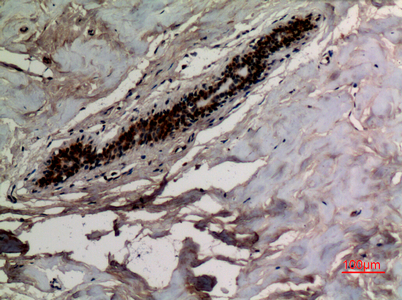Cytokeratin 8 (Acetyl Lys483) Polyclonal Antibody
- Catalog No.:YK0031
- Applications:WB;IHC;IF;ELISA
- Reactivity:Human;Rat;Mouse;
- Target:
- Cytokeratin 8
- Gene Name:
- KRT8
- Protein Name:
- Keratin, type II cytoskeletal 8
- Human Gene Id:
- 3856
- Human Swiss Prot No:
- P05787
- Mouse Swiss Prot No:
- P11679
- Immunogen:
- The antiserum was produced against synthesized Acetyl-peptide derived from human K8 around the Acetylation site of Lys483. AA range:434-483
- Specificity:
- Acetyl-Cytokeratin 8 (K483) Polyclonal Antibody detects endogenous levels of Cytokeratin 8 protein only when acetylated at K483.
- Formulation:
- Liquid in PBS containing 50% glycerol, 0.5% BSA and 0.02% sodium azide.
- Source:
- Polyclonal, Rabbit,IgG
- Dilution:
- WB 1:500 - 1:2000. IHC: 1:100-300 ELISA: 1:20000.. IF 1:50-200
- Purification:
- The antibody was affinity-purified from rabbit antiserum by affinity-chromatography using epitope-specific immunogen.
- Concentration:
- 1 mg/ml
- Storage Stability:
- -15°C to -25°C/1 year(Do not lower than -25°C)
- Other Name:
- KRT8;CYK8;Keratin, type II cytoskeletal 8;Cytokeratin-8;CK-8;Keratin-8;K8;Type-II keratin Kb8
- Observed Band(KD):
- 53kD
- Background:
- keratin 8(KRT8) Homo sapiens This gene is a member of the type II keratin family clustered on the long arm of chromosome 12. Type I and type II keratins heteropolymerize to form intermediate-sized filaments in the cytoplasm of epithelial cells. The product of this gene typically dimerizes with keratin 18 to form an intermediate filament in simple single-layered epithelial cells. This protein plays a role in maintaining cellular structural integrity and also functions in signal transduction and cellular differentiation. Mutations in this gene cause cryptogenic cirrhosis. Alternatively spliced transcript variants have been found for this gene. [provided by RefSeq, Jan 2012],
- Function:
- disease:Defects in KRT8 are a cause of cryptogenic cirrhosis [MIM:215600].,function:Together with KRT19, helps to link the contractile apparatus to dystrophin at the costameres of striated muscle.,miscellaneous:There are two types of cytoskeletal and microfibrillar keratin: I (acidic; 40-55 kDa) and II (neutral to basic; 56-70 kDa).,PTM:O-glycosylated at multiple sites; glycans consist of single N-acetylglucosamine residues.,PTM:Phosphorylation on serine residues is enhanced during EGF stimulation and mitosis. Ser-74 phosphorylation plays an important role in keratin filament reorganization.,similarity:Belongs to the intermediate filament family.,subunit:Heterotetramer of two type I and two type II keratins. keratin-8 associates with keratin-18. Associates with KRT20. Interacts with HCV core protein and PNN. When associated with KRT19, interacts with DMD. Interacts with TCHP.,tissue spec
- Subcellular Location:
- Cytoplasm . Nucleus, nucleoplasm . Nucleus matrix .
- Expression:
- Observed in muscle fibers accumulating in the costameres of myoplasm at the sarcolemma membrane in structures that contain dystrophin and spectrin. Expressed in gingival mucosa and hard palate of the oral cavity.
- June 19-2018
- WESTERN IMMUNOBLOTTING PROTOCOL
- June 19-2018
- IMMUNOHISTOCHEMISTRY-PARAFFIN PROTOCOL
- June 19-2018
- IMMUNOFLUORESCENCE PROTOCOL
- September 08-2020
- FLOW-CYTOMEYRT-PROTOCOL
- May 20-2022
- Cell-Based ELISA│解您多样本WB检测之困扰
- July 13-2018
- CELL-BASED-ELISA-PROTOCOL-FOR-ACETYL-PROTEIN
- July 13-2018
- CELL-BASED-ELISA-PROTOCOL-FOR-PHOSPHO-PROTEIN
- July 13-2018
- Antibody-FAQs
- Products Images
.jpg)
- Western Blot analysis of A549 cells using Acetyl-Cytokeratin 8 (K483) Polyclonal Antibody. Secondary antibody(catalog#:RS0002) was diluted at 1:20000

- Immunohistochemical analysis of paraffin-embedded human-breast, antibody was diluted at 1:100



